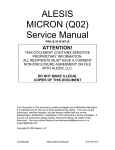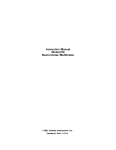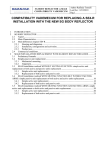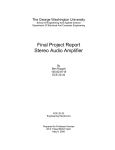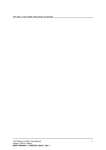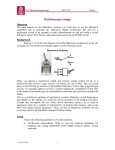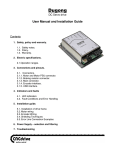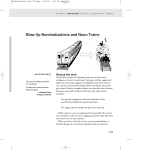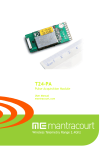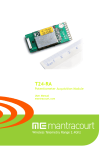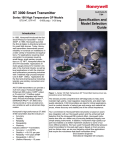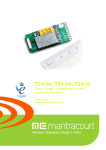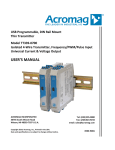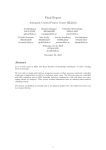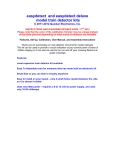Download Sample Report 2 - School of Engineering and Applied Science
Transcript
The George Washington University School of Engineering and Applied Science Department of Electrical and Computer Engineering Final Project Stereo Audio Amplifier Final Report Daniel S. Boucher ECE 20-32, Engineering Electronics May 8, 2000 Professor Korman Faisal M. Yasin Abstract The objective was to design and build an audio amplifier with 3-bit digital volume control and a four-stage output LED display. Power for the circuit was obtained from 120 Vrms at 60 Hz. A center-tapped transformer was used to step down the voltage and a full wave rectifier rectified the circuit. Then capacitors were used to smooth out the signal and +12Vdc regulators were used to maintain +12Vdc. The design of a common emitter circuit (CEC) connected to an AB power amp in a common collector (CCC) configuration was chosen. The design process began with the AB power amp. From that the maximum current was determined. Then the power amp was built to have a gain of one and that determined maximum output current. The first amplifier stage, the CEC, was built to have a gain of twenty since half of the gain would be lost in the transition to the second stage. This was because the input impedance of the second stage and the output impedance of the first were equal. This assured maximum power transfer. The CEC was then DC biased and a potentiometer was used in place of Re to providing slight modifications to the DC biasing while the amplifier was on. The two stages were capacitively coupled to keep each circuits DC biased without affecting the small signal. The volume control was the first small signal stage. It used a summing operational amplifier to control the initial gain of the small signal. This placement was chosen because DC biasing was too sensitive and fidelity would be lost if DC biasing was changed. Also, if the summing op-amp was used at the output, there would be a large power loss, and the components of the summing op-amp, such as the resistors, would heat up. The LED display implemented four op-amp comparator circuits per channel. One voltage ladder was used to give the appropriate reference voltages. 2 One major problem was encountered. It was a hum from the input AC signal. On the 120Vrms line this was a 60 Hz but because I rectified it, the hum in my circuit was at 120 Hz. To reduce this I placed a large capacitor from +12Vdc to –12Vdc to try to cancel this ripple. It was reduced by half, but could still be heard. This interfered with the output at –3db and the music could not be heard at this level. 3 Table of Contents Section 1. Page Abstract 2 2. Specifications 7 3. Theory of Operation 8 4. Circuit Diagrams, Layouts & Wire List 12 5. SPICE Simulation 15 6. Testing Procedures 23 7. Users Manual 24 8. Electrical Parts List 26 9. Conclusions 28 Appendices Appendix A, Amplifier Calculations 29 Appendix B, Volume Control Calculations and Output 30 Appendix C, Measured Output of Rectifier 31 Appendix D, Measured Output Waveform 34 Appendix E, Measured Frequency Response of the Circuit 37 4 List of Illustrations Figure and Title Page Figure 1 – Small Signal Block Diagram 8 Figure 2 – Fictitious Equivalent Circuit 9 Figure 3 – Rectifier Schematic 12 Figure 4 – Digital Volume Control Schematic 12 Figure 5 – Amplifier Schematic 13 Figure 6 – LED Display Schematic 13 Figure 7 – Complete Circuit Schematic 16 Figure 8 – SPICE Output of Rectifier 18 Figure 9 – SPICE Output Waveform 20 Figure 10 – SPICE Frequency Response 22 Figure 11 – Volume Control Output 30 Figure 12 – Measured +12 Vdc Output of Rectifier 32 Figure 13 – Measured -12 Vdc Output of Rectifier 33 Figure 14 – Measured Input vs. Output Waveform (Left) 35 Figure 15 – Measured Input vs. Output Waveform (Right) 36 Figure 16 – Measured Frequency Response (Left) 38 Figure 17 – Measured Frequency Response (Right) 39 5 List of Tables Table and Title Page Table 1 – Wire List 14 Table 1 – Electrical Parts List 26 6 Specifications • The power supply is 120 Vrms at 60 Hz. • CD stereo input (two channels: Left and Right) at 250 mV peak output. • Stereo output. The standard load is an 8 ohm speaker • Volume control per channel: o Digital: 3-bit dip switch control. o Minimum gain (000): -3 dB o Maximum gain (111): 20 dB o Frequency range: of 300 Hz - 10 kHz (without distortion). o Maximum variation in gain over the frequency range: +/- 1 dB • Four level LED Display per channel at 2V, 1V, 0.5V, and 0.25V 7 Theory of Operation This project is a two-channel amplifier. While only one channel is discussed below it should always be assumed that the other channel is identical. The 120Vrms was converted to DC using a full wave rectifier, capacitors, and voltage regulators. The full wave rectifier used 4 DIN4002 diodes, 2 on each tap of the transformer with the center tap as ground. The full wave rectifier was chosen because its ease of use and it did not require many parts. Once the wave had been rectified, large capacitors were placed before and after the voltage regulators to smooth out any distortion. Finally, the +12 and –12 were connected using a 2000uF capacitor to reduce noise in the system. The small signal block diagram is shown below. Figure 1 - Small Signal Block Diagram The volume control used a 3-bit dipswitch and an op-amp in a summing amplifier configuration. For the value of 000, -3dB must be heard. This translates into a gain of 0.7 V/V over the entire circuit. Since the circuit was designed to have a gain of 10 V/V, it can be interpreted that the summing amplifier must have a voltage gain of 0.07 of the input signal. This was achieved using a resistor, Ro, that is in parallel with the dipswitch and a resistor, Rf, which acts as a feedback resistor. The feedback resistor was chosen as 8 1.2 kohms. From this the value for Ro could be determined, 15 kohms. Since the range of this amplifier was from 0.07 to 1.0 in eight equal increments, the values for each level were determined. Then using the values for 001, 010, and 100, the three resistors could be obtained. The complete calculations for this can be found in Appendix B. A CEC amplifier was chosen to amplify the voltage. It has high input impedance. The output impedance can be set equal to Rc if Re is not capacitively coupled. This was very useful because the AB power amp was built first. Then the input impedance of the AB power amp was measured. The output impedance of the CEC (Rc) was set to that value to ensure maximum power transfer. This results in a loss of one half of the gain. This is shown below. Figure 2 - Fictitious Equivalent Circuit From the fictitious equivalent circuit it can be shown that Vin(2) = Rin(2) (Rout(1) + Rin(2)) * Avo(1) * Vin(1) 9 When Rout(1) = Rin(2), Avo(1) it can be shown that Avo(1) will be half. To compensate for this, the gain that the CEC was designed for was twice the final desired gain. The specifications required 20dB at the maximum volume level. This translated to a gain of 10 V/V throughout the entire circuit. This meant that a swing of at least 5 volts would occur at the collector of the BJT. Since Rc had been previously fixed, the collector current had to be adjusted to ensure that approximately 6 volts was present at the collector. This would provide ample room for swing but now Vb had to be determined to maintain the proper biasing of the collector-base junction such that the transistor would remain in the forward active region. This value was determined by performing a voltage divider from Vcc to ground through Rb1 and Rb2. This value had to be small, but it had to be greater than 0.7 volts to turn on the base-emitter junction. The specific calculations are shown in Appendix A. The AB power amp was chosen because it will provide a gain of one and act as a buffer between the CEC and the small load. The power amp also produces a high current gain and thus producing audible sound. The specific values were originally obtained from the midterm project. The values from that were determined from the maximum power rating of the speaker. In this project, a new speaker was bought and the small power limitation was not an issue. Therefore the values of Rb could be reduced, thus producing a greater current, Ic. The resistor values were set a 1k. This caused a serious amount of heat so the resistor values were raised to 3k. This sounded as loud as it did with the 1k resistors and things did not heat up as much. The AB power amp design provided little power consumption when there is not a signal and that is why it was chosen. This complementary symmetric circuit uses diodes 10 to compensate for the loss of signal under 0.7 volts. With the diodes just turned on, this distortion is eliminated. This does cause a slight power loss but it is a reasonable compromise for good quality. To prevent thermal runaway, a one ohm resistance was used as Re. Three threeohm resistors served as a current divider so the resistors would not exceed their power rating. 11 Circuit Diagrams, Layouts, and Wire Lists For clarity, single component schematics are shown below. Figure 3 - Rectifier Schematic Figure 4 - Digital Volume Control (Both Channels) 12 Figure 5 - Amplifier Schematic Figure 6 - LED Display 13 Wire List: Quantity 10 10 4 Length (cm) 1 1 7 Color Red Green Black 1 1 1 1 1 4 4 8 4 4 4 4 1 3 3 4 Yellow Orange Yellow Orange Red Orange Yellow Brown Connect From 12 Vdc -12 Vdc Ground of supply Volume control Volume control CEC CEC 12 Vdc Small signal Small signal Reference voltage Connect To Pin 7 of op-amp Pin 4 of op-amp Ground of all breadboards CEC (left) CEC (right) Power amp Power amp Voltage divider Pin 2 of op-amp Pin 2 of op-amp Pin 3 of op-amp Table 1 – Wire List 14 SPICE Simulation The entire schematic is attached as the next page. 15 INSERT BIG SCHEMATIC 16 The output plot for the rectifier is attached as the next page. +12 Vdc was achieved within approximately 60ms. 17 INSAERT RECTIFIER OUTPUT 18 The output waveform from the simulation is attached as the next page. 19 INSERT OUTPUT WAVEFORM 20 The frequency response of the circuit is attached as the next page. 21 INSERT FREQ RESP 22 Testing Procedures Requirement: Gain of 20dB (10V/V) over the frequency range of 300 Hz – 10kHz Test: Using the function generator, apply an input peak sinusoidal voltage of 250 mV at 300 Hz to the input of the circuit. Attach an eight-ohm resistor to the output of the circuit. Place the leads from the digital oscilloscope over the eight-ohm resistor. Measure the output voltage vs. the input voltage. Determine the gain. Raise the input frequency from 300 Hz to 10 kHz in increments of 100 Hz. Determine the gain at each increment. Requirement: Four level LED Display per channel at 2V, 1V, 0.5V, and 0.25V Test: Turn the circuit on. Using the function generator, apply a sinusoidal voltage to the input of the LED stage. Vary the amplitude of the sinusoidal voltage from 0.0V to 2.5 Volts. The LED’s should turn on according to the reference voltage. Requirement: 3-bit volume control from –3dB to 20dB Test: Using the function generator, apply an input peak sinusoidal voltage of 250 mV to the input of the circuit. Attach an eight-ohm resistor to the output of the circuit. Place the leads from the digital oscilloscope over the eight-ohm resistor. Set the volume control to 000. Measure the output voltage vs. the input voltage. Determine the decibels. Increase the volume control until 111. Measure the decibels at each increment. Results from this test are plotted in Appendix B. 23 User’s Manual i) Operating Instructions a) Plug the plug into the wall outlet b) Connect the small signal source to the orange and yellow leads before the volume control c) Select an appropriate volume level ii) Maintenance Preventative Maintenance Place circuit in a dry, well cooled, shock absorbent enclosure. Routinely check for loose elements. Troubleshooting If the circuit experiences a loss in fidelity, first check the rectifier. Make sure that +12 Vdc are available to the circuit. If not, check the fuses on the transformer, and the voltage regulators. If the rectifier is functioning correctly, apply the small signal after the volume control. If the volume control was the problem test each resistor and replace the op-amps. If the volume control is not the problem, increase the small signal amplitude to 2.5 volts and apply the small signal at the input of the power amp. One of these stages should be the problem. Once the stage is identified, check the DC biasing and replace any parts that do not appear to be functioning correctly. The BJT’s can be tested using the curve tracer. 24 iii) Safety Precautions The transistors in the circuit will get hot. The enclosure must be vented and cooled. The transistors should never come into direct contact with skin. There is a risk of electrical shock if a bare wire is touched. The capacitors are polarized. If capacitors are removed for maintenance or troubleshooting ensure that they are replaced properly. Failure to do so will result in the capacitor exploding which may result in equipment or bodily harm. 25 Electrical Parts List Quantity Circuit Reference Designator Part Name Part Number 8 1N4002 Rectifier Newark Diode 1N4002 470 uF Capacitor Mouser 2 D1, D2, D3, D4, D5, D6, D7, D8 C1, C2 140-XRL50V470 2 C3, C4 1000 uF Capacitor 1 C5 2000 uF Capacitor 4 C6, C7, C8, C9 0.82 uF Capacitor 1 U1 LM7812C LM7812C 1 U2 LM7912C LM7912C 1 SW2 8 Dip Switch 10 U3, U4, U5, U6, U7, U8, U9, LM741 Op-amp LM741 2N3904 NPN Newark Transistor 2N3904 TIP31A NPN TIP31A U10, U11, U12 2 2 Q1, Q4 Q2, Q3 Power Transistor 2 Q5, Q6 TIP32A PNP TIP32A Power Transistor 8 D11, D12, D13, D14, D15, D16, LED MV5753 Mouser 592- D17, D18 Red SLR56VR3 26 2 10 R15, R20 R28, R29, R30, R31, R32, R33, 500 ohm Digi Key Potentiometer 3352W-1-501 1 k ohm resistor R34, R35, R36, R37 5 R27, R28, R1, R4 2 k ohm resistor 2 R25 20 k ohm resistor 2 RoL, RoR 15 k ohm resistor 2 RFL, RFR 1.2 k ohm resistor 2 R2, R5 4.7 k ohm resistor 2 R3, R6 14 k ohm resistor 12 R18, R19, R23, R24 1 ohm resistor 4 R16, R17, R21, R22 3 k ohm resistor 2 RCL, RCR 560 ohm resistor 2 RB1L, RB1R 100 k ohm resistor 2 RB2L, RB2R 22 k ohm resistor Table 2 – Electrical Parts List 27 Conclusions 20 dB is produced at the maximum volume level. Eight unique volume levels are available and the voltage gain of each is linear and is shown in Appendix B. A linear decibel plot for the volume control would have been preferred but was not accomplished. The measured frequency response, Appendix E, exceeds the specifications. This is not necessarily a good thing because it will contain more noise. One problem that was encountered was noise from the AC source. Placing large capacitors from +12 to –12Vdc quieted this some. High fidelity was accomplished at all volume levels, except for 000 because of the line noise. 28 Appendix A, Amplifier Calculations 29 Appendix B, Volume Control Calculations and Results Gain (-V/V) Volume Control Level 1.2 1 0.8 0.6 0.4 0.2 0 Expected Value Left Channel Right Channel 000 001 010 011 100 101 110 111 Binary Level Figure 11 - Volume Control Output 30 Appendix C, Rectifier Output The measure output of 12 Vdc and –12 Vdc is attached as the next two pages. 31 INSERT 12 V OUT 32 INSERT –12 OUT 33 Appendix D, Measured Output Waveform The measured output waveform for both channels is attached as the next two pages. 34 INSERT LEFT CHANNEL OUT 35 INSERT RIGHT CHANNEL OUT 36 Appendix E, Frequency Response The measured frequency response is plotted for both channels as the next two pages. 37 INSERT FREQ RESP LEFT 38 INSERT FREQ RESP RIGHT 39







































